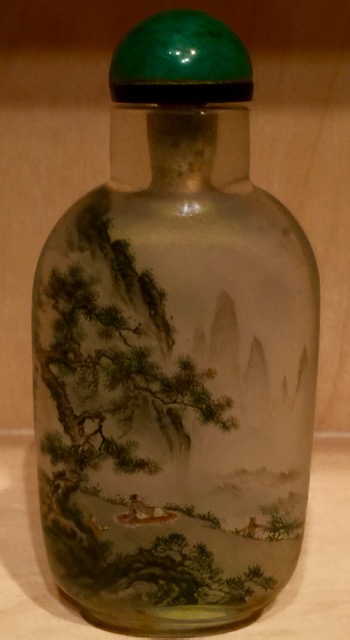
This is a two-inch tall Chinese bottle from the early 1800’s and is decorated with what is called “inside painting.” An artist paints such a bottle on the inside of the glass, backwards, beginning from what would normally be the final strokes on a painting, and working backwards to what would normally be the first introductory strokes of a painting. This is the only way to paint on glass – backwards.
Most of the strokes of this painting were laid down on the inside of the glass by using a specialized paintbrush with only one or two hairs at its end. A painter of the inside of these bottles would produce one a week by working 12 -15 for days, but only if the image was simple, like this one. Much more extravagant images might take a year to produce.
It is hard for me to imagine painting a painting not much bigger than a postage stamp, on the inside of glass, through the neck of a bottle, backwards, in a dimply lit hut.
I saw this bottle while wandering on my lunch hour in the asian collection of the museum of fine arts – a thing I like to do. As I saw this bottle it occurred to me that this is what God is doing inside all of us, painting an image inside us – an image of an ongoing nature and of great beauty. At the same time, some of the choices we humans make are the equivalent to ingesting turpentine, such that one swish means that God must begin again after weeks or years of work. And does. Patiently, Kindly. Determinedly.
Like a Chinese inside-painting bottle, we humans hold the Holy Spirit as individual temples. We each have this beautiful image being painted inside of us by God. And in a way, the painting is being painted backwards because what one first sees in an encounter with any human being is only the tip of the beauty-iceberg, only the few first strokes of a detailed painting God is working out by applying layer after layer of paint, in thousands of colors, one hair-stroke at a time, backwards.
Sometimes I meet or experience people who are naturally cruel, or stupid, or, most dangerously, both if they have any power at all. Sometimes I meet people of immense privilege whose wealth emerges from their talents and gives them power. And sometimes I meet wealthy people who exude a kind of imperious entitlement – people for whom humility is something for the poor. And I try, hard, to remember that God is still at work inside them, creating a painting that I cannot fully see, or perhaps that is simply not a painting that I enjoy but is perhaps a painting that others enjoy.
As the Episcopal Church begins to implode and its members age and die out, it is being replaced with something new. The anxiety in the air is startling and so is the reality of what it is producing in our systems. The Episcopal church will not be funded the same way it always has. It will not be staffed the same way either. But it will exist even if in a somewhat different form. Some churches are already making courageous changes to survive and thrive in a new shell – a new bottle – a new world. While others will be the Downton Abbeys of the church – elegant, massive, confused by the changes around them, and ultimately, lost to history and to a charming, if meaningless memory, much the way we remember the church as seen in Anthony Trollope’s Barchester Towers – charming and extinct. And Jesus is overseeing these changes, never absent. Always begging the church to return to the things Jesus was doing and saying – live simply, love each other, care for the poor – you know, the basics. But we like this church we have created and we like its toys and baubles.
So what we can and must do now, today and together, is to acknowledge that God is busy painting inside us and inside this church. And we must allow that painting, while avoid drinking turpentine in whatever forms it comes. And it usually comes in the form or power, prestige and privilege – the tree old temptations of the desert wilderness in which Jesus faced down evil. The ones which, like beauty, are the ancient-modern realities of our life just as they were of Jesus’.

